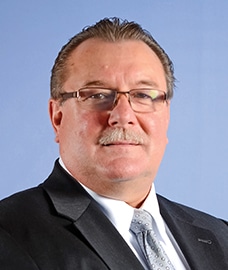John Lesniewski, vice president and successor president of the Transportation Division of the International Association of Sheet Metal Air, Rail and Transportation Workers, has retired, effective July 1, 2018.
Lesniewski, a member of Chicago Local 1534, started his railroad career on the Baltimore and Ohio Chicago Terminal Railroad (CSXT) on Oct. 29, 1972. After holding local offices with the then-United Transportation Union (UTU), Lesniewski was elected local chairperson in 1982 and was re-elected by acclamation in 1986, 1990, 1994 and 1998, serving for more than 16 years. He also served as the local’s delegate at UTU conventions in 1987, 1991, 1995, 1999 and 2003.
“It has been my privilege and pleasure to serve the membership as an officer of our great Union for almost 36 of my 46 years of railroad service. My sincere thanks to all of the Union members, officers and staff who have supported me along the way,” Lesniewski said. “I will never forget you.”
In 1995, Lesniewski was elected part-time secretary of the CSXT/B&O General Committee (GO-049) after 26 years as a trainman and 16 years as a part-time representative. He was elected by acclamation to a full-time position as first vice general chairperson in 1999 and re-elected to that position in 2003. Upon the retirement of former General Chairperson J. T. Reed on July 1, 2004, Lesniewski was elected by acclamation as general chairperson on the former B&O CSXT property and then re-elected for successive terms by acclamation in 2007 and 2011.
On Feb. 28, 2011, Lesniewski was elected as second alternate vice president-East by the UTU board of directors and was subsequently elected, overwhelmingly, as a full vice president by delegates at the 2011 UTU Convention and re-elected to the position at the SMART TD convention in 2014. At the 2014 convention, he was also elected “successor president” by the delegates. He also served as general vice president on the General Executive Council of SMART.
Lesniewski served on the National Negotiating Committee for the July 1, 2008, National Mediation Agreement under both former-Presidents P. C. Thompson and M. B. Futhey Jr. He also served on the 2011 National Negotiating Committee, having been appointed by Futhey in December 2009. He served on his third National Negotiating Committee starting in 2015, having been appointed by Transportation Division President John Previsich, which resulted in the National Rail Agreement that was ratified Dec. 1, 2017.
“As I step aside, I encourage younger members to get involved in the labor movement to protect their own future as well as the future of their co-workers,” Lesniewski said. “Being a Union representative, in any capacity, is a prodigious source of personal satisfaction if it is undertaken for the correct purpose of making a difference by helping and protecting our membership.
“As an added bonus, within our Union, you end up working with a dedicated group of consummate professionals as I have.”
President Previsich commented: “I have had the pleasure of working with Brother Lesniewski during my entire career as a nationally elected officer. His professionalism and expertise are at the highest level and his integrity and commitment are confirmed by all who know him. John has been a tremendous asset to our union in all respects and a close and dear friend to me personally. It is my distinct honor to wish John and his wife, Gail, a long, healthy and prosperous retirement.”
John and Gail have been married for 45 years and reside in Noblesville, Ind. They have four children, three of whom are married, and eight grandchildren.
The vacancy created by Lesniewski’s retirement will be filled by the elevation of Alternate Vice President Brent Leonard, effective July 1.
Leonard, 45, has served as SMART TD alternate vice president since Jan. 1, 2013. He was elevated to the position by the Board of Directors on Dec. 28, 2012, and was re-elected to the position in 2014.
A member of Local 202 in Denver, Leonard started railroading in 1997 on Union Pacific as a conductor/switchman. He was promoted to engineer in 1998 and was elected local chairperson in 2001. He was elected vice general chairperson of his general committee, GO-953, in 2003; senior vice general chairperson in 2007 and general chairperson in 2011. GO-953 represents about 4,000 members and is one of the largest general committees in SMART TD.
As general chairperson, Leonard represented Union Pacific employees encompassing 10 states as well as four regional short-line railroads representing both operating and non-operating crafts. Leonard negotiated several first-of-their-kind agreements providing significant pay increases, improvements to his members’ quality of life and predictive time off.
Leonard has filled past roles of chairman of Union Pacific Railroad Employee Health Systems (UPREHS), chairman of the District 1 General Chairpersons’ Association and has served in various leadership positions for the Union Pacific General Chairpersons’ Association.
Leonard and his wife live in Topeka, Kan., and have two daughters.
Tag: John Lesniewski
UTU Local 440 represented train and engine workers employed by Central Railroad Company of Indiana have ratified, by a 91 percent approval, a new five-year collective bargaining agreement effective Jan. 1.
The agreement provides for annual wage increases, an additional paid holiday, flex days, enhanced overtime provisions, enhanced instructor allowance, additional meal allowance and improved bereavement leave.
UTU International Vice President John Lesniewski, who assisted with the negotiations, thanked General Chairperson Andy Combs (CIR), Vice General Chairperson Tony Livengood and General Committee Secretary Bruce Huff for their “exceptional dedication and commitment in securing the most beneficial agreement possible for their members, which resulted in substantial improvement of their wages and working conditions.”
Central Railroad Company of Indiana is a RailAmerica short-line that stretches through five southeastern Indiana counties and into Ohio, operating 96 miles of track. It interchanges with Canadian National, CSX, and Norfolk Southern, providing an integral link between Indiana and Ohio in this area. The railroad moves more than 11,000 cars annually, primarily transporting automobiles, chemicals, metals and aggregates.
WASHINGTON – It’s now official. Conductor certification, mandated by the Rail Safety Improvement Act of 2008, became effective Jan. 1.
In a final rule, published by the Federal Railroad Administration Nov. 9, railroads were ordered to implement, by Jan. 1, a formal training program for certifying conductors and a formal process for training prospective conductors, thus ensuring job competency.
The FRA’s final rule on conductor certification follows many of the provisions of locomotive engineer certification, with a number of improvements the UTU, joined by the BLET, was able to obtain.
Following are highlights of the final rule, which ran almost 300 pages in the Nov. 9 Federal Register.
* While the railroad and its employees must comply with the final rule, there is no limitation on any rights the employee may have under a collective bargaining agreement
* Conductors currently employed will be grandfathered for from one to three years, with one-third of those conductors required to be tested for certification in 2012, 2013 and 2014. Beginning in 2015, one-third of the total conductor workforce will be recertified each year.
* Each railroad, in submitting its proposed certification program to the FRA for approval, must simultaneously submit it to the presidents of the UTU and BLET, which will have 45 days to comment. The intent is to encourage coordination by carriers with local union officers in formulating the certification program, and to gain a supporting statement from the general committee of jurisdiction.
* A conductor losing certification may work as an assistant conductor, brakeman, yard helper, switchman or utility employee, but cannot work as a locomotive engineer. If that individual holds both conductor and engineer certification, and the engineer certification is revoked, they may not work as a conductor.
* If the conductor certificate is revoked because of failing to control a train, violation of train speed, violation of brake test requirement, occupying main track without proper authority, tampering with safety devices, or an alcohol or drug violation, the decertified conductor may not work as a locomotive engineer. However, if the decertification is for violation of a rule covering shoving or pushing movements, or equipment left out to foul track, switches and derails, the decertified conductor may work as a locomotive engineer.
* The conductor must be trained by a qualified person on the territory over which that conductor will operate. If the certified conductor lacks territorial qualification, and has never been qualified on main track physical characteristics, that conductor shall be assisted by a person who is a certified conductor qualified on the territory, and NOT a member of the crew.
* If the conductor has been previously qualified over the main track territory, and the time limits have expired on their qualification, the conductor may be assisted by any knowledgeable person, including a member of the crew, other than the locomotive engineer on the crew, so as not to conflict with other safety sensitive duties.
* If the conductor lacks territorial qualification on other than main track, the conductor, where practical, shall be assisted by a certified conductor meeting the territorial qualifications. Where this is not practical, the conductor shall be provided an appropriate job aid, which includes maps, charts or other visual aids of the territory. This applies to all tracks on each territory.
* Territorial qualification is not required for short movements of one mile or less where track speed is 20-mph or less and movement is required to be at restricted speed, and the track grade is less than 1 percent.
Prior to revoking conductor certification, a railroad must:
* Provide notice of the reason for suspension, and an opportunity for a hearing before a person other than the investigating officer. Written confirmation of the notification shall be in accordance with the collective bargaining agreement. Additionally, the hearing shall be in accordance with the collective bargaining agreement, but shall be convened within 10 days after the certificate is suspended, unless the conductor asks for a delay.
* Provide, no later than convening the hearing and notwithstanding any collective bargaining agreement, a copy of the written information and a list of the witnesses the railroad intends to present at the hearing. The railroad shall grant a recess if the information is provided just before the hearing. If the information is provided through written statements of an employee, the railroad shall make that employee available for examination during the hearing.
* Not revoke certification or recertification if there is sufficient evidence that an intervening cause prevented or materially impaired the conductor’s ability to comply with requirements.
Additionally, with regard to conductor certification:
* The appeal procedures largely mirror engineer certification regulations.
* The training requirements for new conductors are significantly improved from current requirements. In addition to improved initial training, this rule requires recurrent training for all conductors every three years during the recertification process. The recurrent training must be identified in the certification plan filed with FRA, including changes in operating rules, operating practices, new federal regulations and new equipment in service.
“The implementation of conductor certification enhances the skills and safety performance of freight and passenger conductors, provides a federal license ensuring proper training of conductors, and establishes a new basis for resisting management pressure to violate operating rules and federal regulations,” said UTU International President Mike Futhey.
The final rule is a result of input from all affected parties, including labor, through the FRA’s Rail Safety Advisory Committee (RSAC).
The UTU was represented on this RSAC Conductor Certification Working Group by Local 645 Chairperson Vinnie Tessitore, Local 1470 Chairperson David Brooks, General Chairperson (GO 049) John Lesniewski, Local 528 Legislative Representative Ron Parsons, Alternate National Legislative Director John Risch, National Legislative Director James Stem, and UTU Rail Safety Coordinator for Designated Legal Counsel Larry Mann.
Click here to read the 278-page final rule on conductor certification.
Click here for more information on conductor certification.



